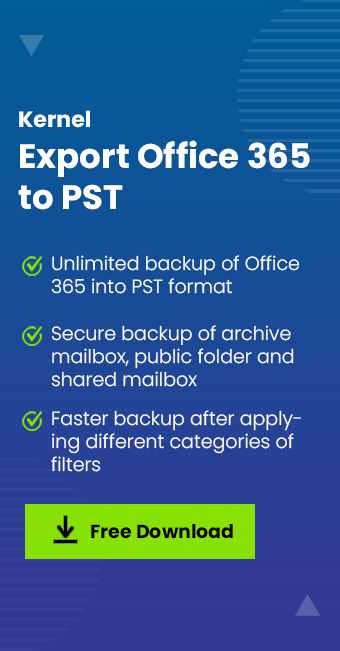Read time: 6 minutes
Security ranks as a paramount concern for organizations employing Office 365. While Microsoft offers robust native security features within Office 365, many organizations seek supplementary solutions to ensure thorough data security and compliance management.
The same holds true for organizations working with hybrid deployments, which integrate on-premises Exchange environment with Office 365. This connects mailboxes, contacts, calendars, etc. from on-premises Exchange to Office 365 by simply syncing Office 365 Active Directory with the on-premises AD. Although Microsoft provides guidance for hybrid management, effectively managing such deployments can be challenging without the appropriate tools in place.
In this guide, we will explore Office 365’s native security features and delve into the considerations when adopting a hybrid approach to manage your Office 365 deployment. Additionally, we will offer valuable tips for selecting the appropriate tools to enhance the security and management of your Office 365 deployment, regardless of whether it’s hybrid or fully cloud based.
Native tools for Office 365 & Hybrid management
Hybrid deployments of Office 365 help to improve the collaboration and provide more administrative control over their Exchange environment. Microsoft offers various native tools for managing Office 365 security and compliance, including the Security & Compliance Center, Azure Active Directory (AD), Microsoft Intune, and more.
- The Security & Compliance Center is a central location for managing security and compliance in Office 365. It includes features such as data loss prevention (DLP), eDiscovery, retention policies, and auditing. The Security & Compliance Center can be accessed by admins from the Office 365 admin center.
- Azure AD is Microsoft’s cloud-based directory service. It is used to manage user identities and access to resources, such as Office 365. Azure AD offers capabilities such as multi-factor authentication (MFA) and device management.
- Microsoft has also introduced Modern authentication login to boost the security of Microsoft 365 logins and save the data from breaches. This method is more secured than the Basic authentication which was used earlier.
- Microsoft Intune is a cloud-based Mobile Device Management (MDM) solution. You can use it to manage mobile devices accessing Office 365 resources. Microsoft Intune offers device configuration, app management, and security management. You can protect your Office 365 mailbox from ransomware attacks, virus & other threats.
Benefits of using Native tools for Office 365
We are now aware of the native tools within Office 365 that help in hybrid management and data security. It’s time to move to learn how these tools help in Office 365 Hybrid management.
- Reduced complexity
Utilizing native tools for Office 365 security and compliance eliminates the necessity of deploying and managing additional third-party solutions, thereby simplifying your environment and reducing complexity. - Increased visibility
The Security & Compliance Center serves as a centralized hub for overseeing the security of your Office 365 deployment, facilitating the rapid identification and resolution of potential threats. - Improved performance
Azure AD and Microsoft Intune are tailored to seamlessly integrate with Office 365, delivering superior performance compared to third-party alternatives. - Better integration
Native Office 365 security and management tools provide seamless integration with Microsoft’s suite of products and services, simplifying the management of hybrid deployments that encompass both on-premises and cloud-based resources. - Cost savings
Leveraging native tools for Office 365 security and Hybrid management eliminates the necessity to acquire and implement additional third-party solutions, resulting in cost savings for your organization. - Better flexibility
The native tools available for Office 365 offer increased flexibility than third-party solutions. For example, you can use Azure AD to manage user identities for both on-premises and cloud-based resources just by syncing both the directories.
Are Native tools sufficient to manage Office 365 properly?
No security solution is strong enough to escape from breaches completely and Office 365 is no different. It is also vulnerable to crashes or corruption at times and therefore requires the administrator to take appropriate steps in time. While Microsoft provides several native tools for securing and managing Office 365 deployments, it’s important to acknowledge their limitations too. This will allow you to avoid downtime and prevent data loss in Exchange Online.
- Limited control
Native tools provide limited control. For example, you cannot use the Security & Compliance Center to block specific users from accessing Office 365 resources. - Lack of customization
Office 365’s security features are crafted to cater to a wide array of customers, resulting in limited flexibility when it comes to customization to suit your organization’s specific requirements. - Complexity
The native tools for Office 365 management can be complex to deploy and manage. This can make it difficult to get the most out of them. In case you are struggling with Office 365 connectivity issues, seek technical support from the experts and resolve issues before the security of overall data is compromised. - Limited support
Microsoft provides limited support for the native Office 365 security and management tools. In case of issues, you might have to depend on community forums or opt for paid support options. - Incompatibility
The native Office 365 tools may not be compatible with all Office 365 versions; for instance, the Security & Compliance Center is exclusive to the Office 365 Enterprise E5 plan.
However, despite these limitations, native tools remain the optimal choice for managing Office 365 security and compliance. Their advantages outweigh the drawbacks, and when utilized effectively, they can ensure high security and compliance of your Office 365 deployment. For a comprehensive Office 365 security solution, we suggest considering a hybrid approach, combining native tools with third-party solutions. This approach offers the advantages of flexibility and control through third-party tools while retaining the simplicity and cost-effectiveness of native tools, providing the best of both worlds.
Considering a Hybrid approach
When determining the optimal approach for managing your Office 365 deployment, a hybrid strategy is worth considering. This approach combines the advantages of both on-premises and cloud-based management tools. By adopting a hybrid approach, you can enhance the management of your Office 365 deployment while retaining data control. If you are contemplating this approach, keep the following considerations in mind:
- You will need to deploy and manage both on-premises and cloud-based management tools.
- It is important that your on-premises and cloud-based management tools are compatible with each other.
- Ensure that you have a plan for managing user access to both on-premises and cloud-based resources.
- You should make sure your data is backed up and secured both on-premises and in the cloud.
- Prepare a plan for how you will transit data between on-premises environment and cloud-based storage, i.e. migrate Exchange server to Office 365.
Adopting a hybrid approach to Office 365 hybrid environment management allows effective utilization of both on-premises and cloud-based management tools. This approach enhances your ability to manage your Office 365 deployment efficiently while retaining control over data. Moreover, follow further section in case you are seeking for easy Office 365 Backup methods and prevent data from unexpected instances.
Office 365 Backup: An added security measure
Having observed the evolution of native tools for Office 365 Security & Management, it’s prudent to bolster your protection with Office 365 data backup. Absolutely, it’s a must. We are here to help you through with an easy tool to backup Office 365 data which is Kernel Export Office 365 to PST.
This tool offers a number of features that make it an ideal solution for backing up Office 365 data. First, it allows users to perform an unlimited number of backups in a variety of formats, including PST, HTML, PDF, MSG, DOC, and DOCX. Additionally, the tool provides an easy process to Export Office 365 to PST and automated backup capabilities using an inbuilt CSV file. This allows users to schedule backups according to their needs and ensure that their data is always protected.
Furthermore, the tool includes smart filters that allow users to choose which data they would like to include in their backup. Finally, the tool preserves the folder hierarchy in a separate folder so that users can easily access their backed-up data. All these features make this Office 365 to PST tool a necessity for those who needs to protect their Office 365 data.
Last say
While native tools serve as a solid foundation for managing Office 365 security and hybrid deployments, they may fall short of comprehensive protection and management. By adopting a holistic approach, incorporating both native and third-party tools, organizations can bolster the security and effectiveness of their Office 365 implementation. Furthermore, we provide the top Kernel Export Office 365 to PST tool to complement your existing setup.








